Today, commuters take the fact that trams run on most Budapest bridges for granted. However, this was not always self-evident, and laying tracks between the two halves of the city has sparked several debates. The first bridge in Budapest in connection with which the possibility of track-based transportation was raise was Margaret Bridge, as horse-drawn railways already crisscrossed the city by its construction.
.jpg)
Margaret Bridge around 1894. Tracks can be seen on the side of the image (Photo: Fortepan / Budapest Főváros Levéltára. No.: HU.BFL.XV.19.d.1.07.049).
The government did not initially plan to have tracks lain on Margaret Bridge. The bridge was discussed several times, and the possibility of bringing horse-drawn railways across it was discussed on 19 July 1872. The Minister of Finance informed the government that if tracks were not built into the bridge, it would not only be narrower but 270,000 Forints cheaper.
The government hoped to force companies operating the horse-drawn trams to pay the difference. Negotiations began but were not completed before the construction of the bridge was finished. As a result, horsecars only crossed the bridge from 1879, following a contribution made by the Pesti Közúti Vasút Társaság (pest Public Road Railway Company). In 1894 horse-drawn tram were replaced by trams.
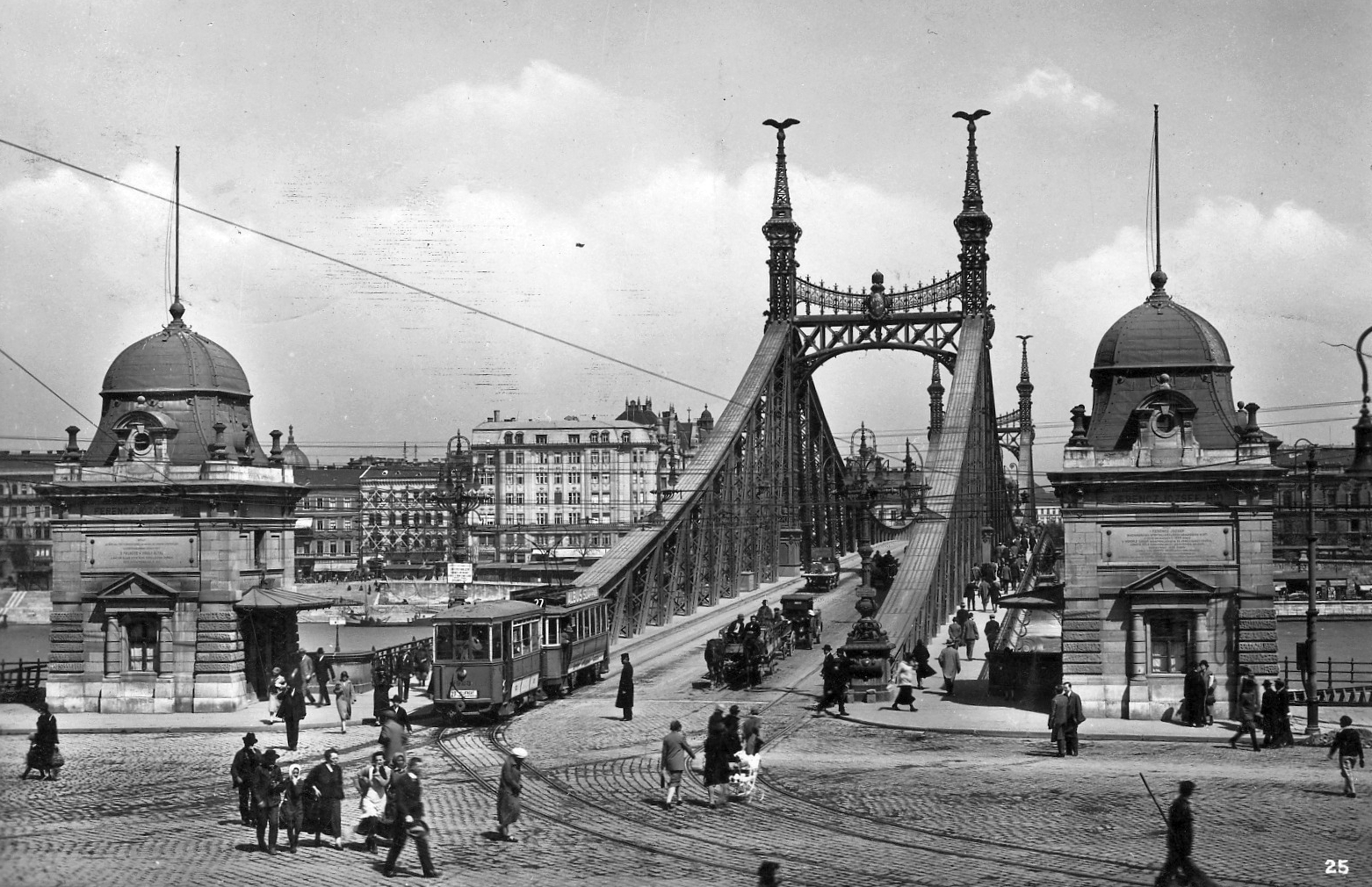
Trams ran on Franz Joseph Bridge form 1898. On the 1926 photo the tram is powered through an overhead line (trams were powered by a third underground rail in Budapest for a long time) and, naturally, keeps left. (Photo: Fortepan / No.: 32578)
It was evident that tracks would be lain on all later bridges. The Franz Joseph and Elizabeth Bridges were constructed as such. Trams started operating on the Franz Joseph Bridge in 1898, less than two years after it was opened. In the 1970s and 80s, the need to demolish the tramlines on the bridge was almost considered a fact, as engineers believed the structure would not be able to bear the load caused by heavy road vehicles.
Luckily, during a recent renovation efforts to reinforce the structure were a success and trams will continue to cross one of Budapest's most fabulous bridges for decades to come.
It took 11 years for trams to use the tracks built into Elizabeth Bridge following its completion in 1903. The tram operators in Budapest (BKVT and BVVV), could not reach an agreement with the Government and City Council regarding the use of the tracks. The debate was exacerbated by the fact that plans for the reconstruction of Chain Bridge were being completed at the time, and Elizabeth Bridge would have played a major role as a diversion route in the two years Chain Bridge was to be closed. Trams operations finally began in 1914 after years of negotiations.
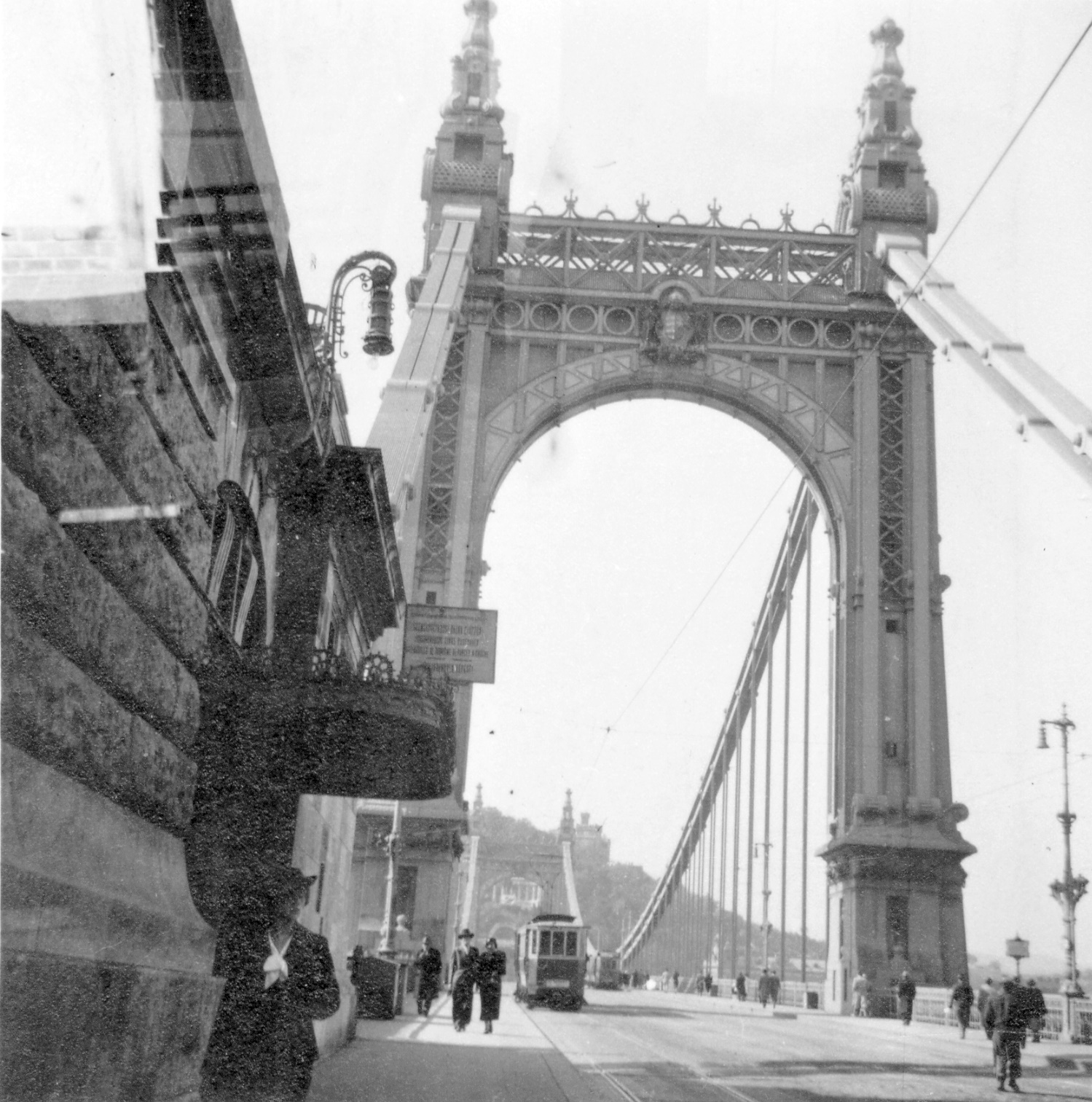
Tram crosses Elizabeth Bridge in 1934. At the time rules regulate that pedestrians only move in one direction on each pavement )Photo: Fortepan / No.: 47425)
As bridge tolls were still being collected, many used trams as a way to avoid the costs. Children would often appeal to the instincts of female conductors, while adults used a different method. The most common was to board the tram on the Pest side (the toll was only paid when crossing form Pest to Buda) and then ask for a ticket to a station in the wrong direction, on the pest side, when the tram was already on the bridge. Upon learning they had boarded the wrong tram, they simply alighted on the Buda side.
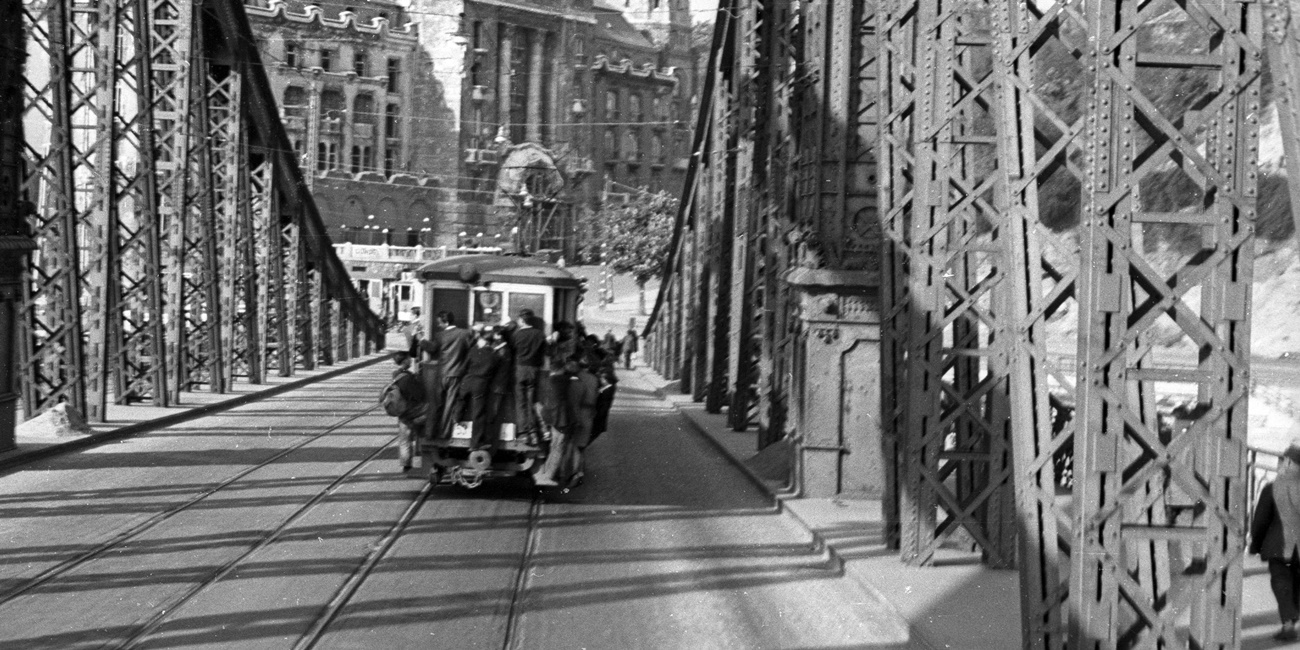 "Tujázás", or surfing as it is now sometimes called – i.e. holding on to the outside of the tram illegally – used to be a common occurrence in Budapest. These "passengers" hoped to avoid the cost of a ticket rather than the bridge toll (Photo: Fortepan / No.: 78834)
"Tujázás", or surfing as it is now sometimes called – i.e. holding on to the outside of the tram illegally – used to be a common occurrence in Budapest. These "passengers" hoped to avoid the cost of a ticket rather than the bridge toll (Photo: Fortepan / No.: 78834)
From 1913 the old Connecting Railway Bridge was replaced by a new bridge right next to it. However, as the old bridge was not demolished the idea to use it as part of a tram line was floated. However, as the bridge was far from the city at the time, and trams only being able to cross the old structure with a great deal of noise, the plans were dropped.
Bridges built and planned in the inter-war years also had tram tracks. Tram tracks were rebuilt on all bridges following the destruction of World War II. Before the completion of the Újpest Railway Bridge, the tracks on the newly built Árpád Bridge – officially called Stalin Bridge for six years after its completion in 1950 – were used by trains as well as trams.
Árpád Bridge was reconstructed between 1980 and 1984. The outer parts of the original structure were demolished, and tram tracks lain on the remaining elements of the old structure. Road traffic was routed over to new bridges placed tightly either side o the old structure. The trams on the bridge were known as the "fast trams" for a while, as plans to create a tram line faster than the usual on the bridge were also created.
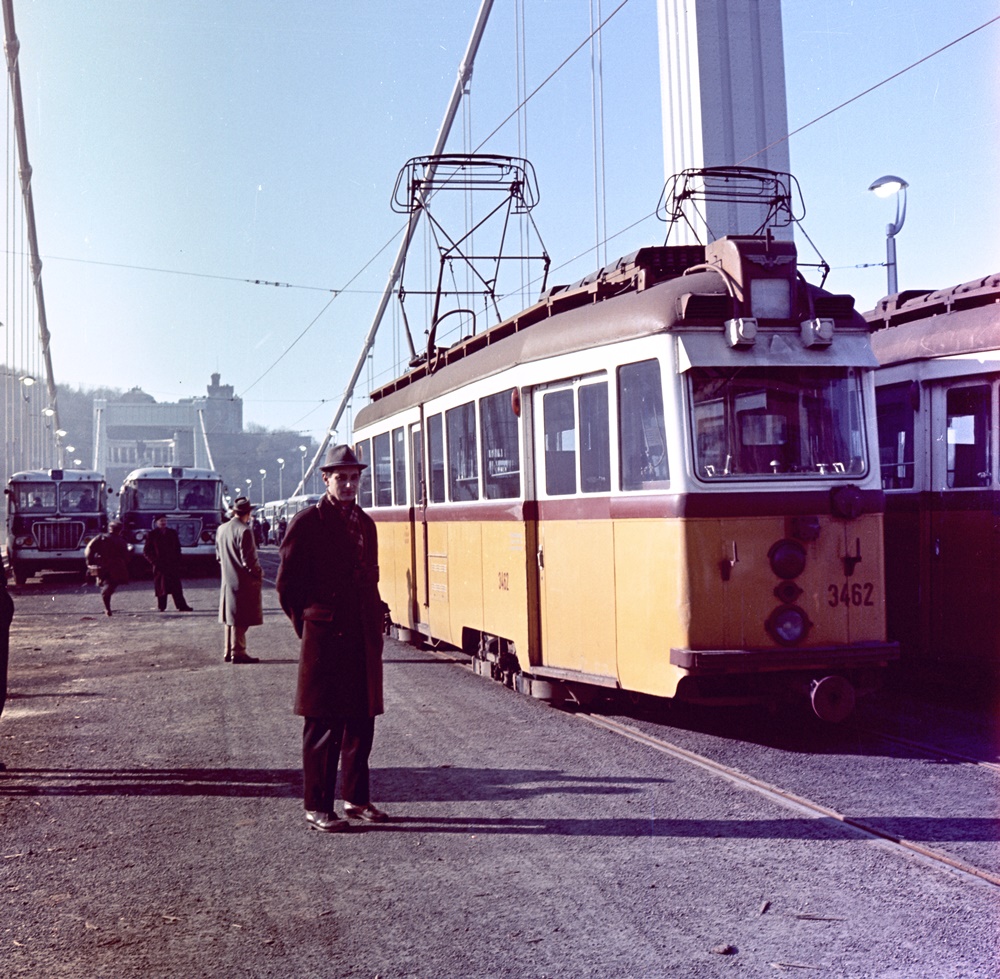
Trams played an important role in the load test of Elizabeth Bridge (Photo: Fortepan / No.: 59963)
Trams did run on the rebuilt Elizabeth Bridge as well, between 196 and 1972. The tracks were primarily taken up for two reasons. The route had always been considered temporary, planned until the completion of the metro. Thus, tracks were placed directly on the steel structure without proper anchoring. As a result, only more modern trams with rubber suspensions systems could cross the bridge, and microscopic cracks were still found in the structure due to the vibrations caused by the trams. The tracks were removed from the bridge after the completion of the M2 underground line.
Tramlines were not included in the plans for new bridges. The Lágymányos Bridge (Rákóczi Bridge) and Galvani Bridge, first designed in 1992, would have only been used by road vehicles.
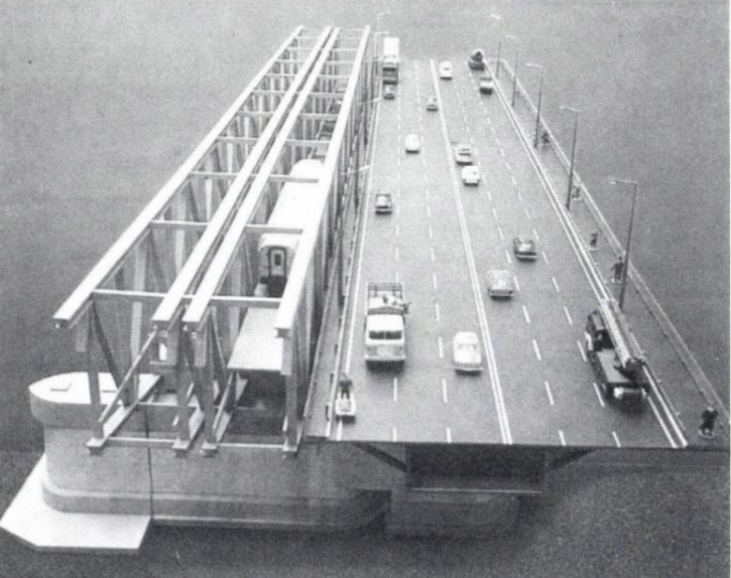
Plans for Lágymányos Bridge, a model form 1988. No tram tracks. (Photo: Budapest, April 1988)
Several plans and designs for Lágymányos Bridge, the present-day Rákóczi Bridge were completed, yet non of these included a tramway. The idea to cross the river with tracks on the new bridge only appeared in the 1990s, and on the plans completed afterwards. Despite the bridge being completed in 1995 and the room and anchorage from tram tracks being in place, the first tram only crossed the structure some 20 years later in 2015. Before then, Tram line 1 terminated at the Pest bridgehead.
The capital announced a design tender for a new bridge near Galvani Street in 1992, for a bridge with 2x3 lanes for road traffic. Guided transport tracks were only added to the design requirements in the newest tender, for which the public procurement announcement was recently made.
This shows that tram connection between the two sides of the river will remain a part of Budapest for decades to come.
Cover photo: Tram crosses Elizabeth Bridge in 1970 (Photo: Fortepan / No.: 75625

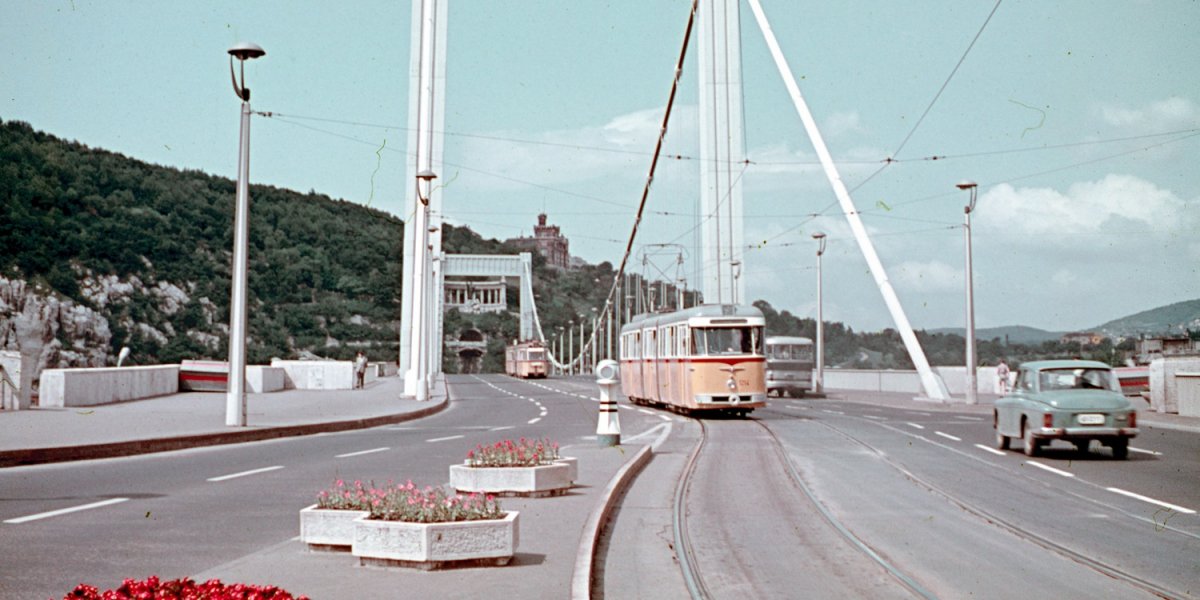



































Hozzászólások
Log in or register to comment!
Login Registration